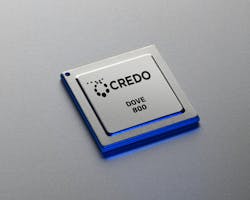Credo unveils Dove 800-Gbps, 400-Gbps optical DSPs with integrated drivers
Credo Technology Group Holding Ltd. (NASDAQ: CRDO) now offers the Dove 800 Digital Signal Processor (DSP) line. The family, which includes 400G devices as well, are PAM4 DSPs with integrated EML, thin-film lithium niobate (TFLN), and silicon photonics modulator drivers and offer “industry-leading performance and low power dissipation,” according to the company.
The Dove 800 family includes the 800-Gbps Dove 800/801/802 for OSFP and QSFP-DD800 optical transceivers and the 400-Gbps Dove 410/401/401 for QSFP112 modules. Features include:
- 100G PAM4 on both the electrical host and optical line side; Credo says the DSP offer industry-leading sensitivity and BER performance to allow margin for optical alignment and crosstalk.
- Line side receivers include non-linear cancellation and reflection cancellation to improve yields while reducing costs
- Transmitters come with multi-tap FIR filters and non-linear cancellation, which enables precision optimization at both the module electrical connector and optical interface
- Host-side interface support of up to 30 dB insertion loss channel; the interface is designed to connect seamlessly with different length switch interfaces without the need for customized per-channel settings.
- In addition to the EML, TFLN, and silicon photonics drivers, the line features bias-T but allows use with external laser or modulator driver support
- Independent phase-locked loops per channel support multiple breakout configurations including 2x400G, 4x200G, and 8x100G
- A full suite of test features and loopbacks
- On-chip crossbar to simplify module layout design.
- The low-power dissipation enables higher rack utilization and lower thermal cooling requirements.
"Credo is delivering a comprehensive solution with the Dove 800 family – its low-power, high-performance design, combined with integrated drivers and bias-T components, will enable customers to simplify PCB design, improve yields and reduce module costs,” said Scott Feller, vice president of marketing at Credo. “The Dove 800 family supports low-cost, quick implementation required to support the hyperscale and AI applications driving the demand for high-density switching systems.”
“Continuous increase in data traffic, driven by applications such as AI and AR/VR, is fueling the demand for optical modules with increased thruput and switch ASICs with 100Gbps serial interface,” said Vlad Kozlov, founder of LightCounting Market Research, via a Credo press release. “In fact, we have increased our forecast for 800G transceivers reflecting higher level of investments planned by Meta. Credo’s high-performance 400-Gbps and 800-Gbps DSPs are critical to enabling this next-generation infrastructure, while providing the power and price required for rapid market deployment and volume ramp up.”
For related articles, visit the Optical Technologies Topic Center.
For more information on optical components and suppliers, visit the Lightwave Buyer’s Guide.
To stay abreast of optical communications technology, subscribe to Lightwave’s Enabling Technologies Newsletter.
About the Author

Stephen Hardy
Editorial Director and Associate Publisher, Lightwave
Stephen Hardy is editorial director and associate publisher of Lightwave and Broadband Technology Report, part of the Lighting & Technology Group at Endeavor Business Media. Stephen is responsible for establishing and executing editorial strategy across the both brands’ websites, email newsletters, events, and other information products. He has covered the fiber-optics space for more than 20 years, and communications and technology for more than 35 years. During his tenure, Lightwave has received awards from Folio: and the American Society of Business Press Editors (ASBPE) for editorial excellence. Prior to joining Lightwave in 1997, Stephen worked for Telecommunications magazine and the Journal of Electronic Defense.
Stephen has moderated panels at numerous events, including the Optica Executive Forum, ECOC, and SCTE Cable-Tec Expo. He also is program director for the Lightwave Innovation Reviews and the Diamond Technology Reviews.
He has written numerous articles in all aspects of optical communications and fiber-optic networks, including fiber to the home (FTTH), PON, optical components, DWDM, fiber cables, packet optical transport, optical transceivers, lasers, fiber optic testing, and more.
You can connect with Stephen on LinkedIn as well as Twitter.
